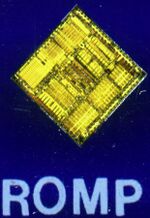ROMP
| Designer | IBM |
|---|---|
| Bits | 32 |
| Introduced | early 1980s |
| Design | RISC |
| Type | Register-Register |
| Encoding | Variable (2 or 4 bytes long) |
| Branching | Condition code |
| Page size | 4 KB pages |
| Registers | |
| General purpose | 16× 32-bit |
The ROMP or Research OPD Micro Processor was a 10 MHz RISC microprocessor designed by IBM in the early 1980s. It is also known in some circles as 032. "OPD" stands for "Office Products Division", the division of IBM which originated the processor. The ROMP was manufactured on a 2 µm process with 45,000 transistors, saw first in silicon in 1981, and was originally developed to be used in office equipment and small computers.[1] It was intended as a follow-on to a mid-1970s processor called the "OPD Mini Processor", which was used in text editing systems such as the IBM Office System/6.[citation needed] ROMP originally was shipped in the IBM RT/PC line, announced in 1986, and was later used in an IBM laser printer. For a time the IBM RT/PC was planned to be a personal computer, with ROMP replacing the Intel 8088. However, the software was targeted more towards engineering workstations.
The original ROMP had a 24-bit Reduced Instruction Set Computer (RISC) architecture developed by IBM, but the instruction set was changed to 32 bits a few years into the development.[2] It was originally implemented in a 2 µm NMOS technology. It had sixteen 32-bit general purpose registers and used 32-bit addresses and data paths. The microprocessor was controlled by 118 simple two- and four-byte instructions. Internal processor organization enabled the CPU to execute most register-to-register instructions in a single cycle. An IBM-developed advanced memory management chip provided virtual memory address translation functions and memory control.
The architectural work started in late spring of 1977, as a spin-off of the T.J. Watson Research 801 processor (hence the "Research" in the acronym). Most of the architectural changes were for cost reductions, such as adding 16-bit instructions for byte-efficiency.
The first chips were ready in early 1981. Thus, ROMP was possibly the first working commercial RISC, depending on whether it was a true RISC and whether one could count it as a commercial product in 1981, since it didn't actually ship until 1986. This delay was caused by overly ambitious software plans for the RT/PC and its operating system (OS). This OS virtualized the hardware and could host multiple other operating systems, though UNIX was the only operating system to be ported to the underlying virtual OS. This technology, called virtualization, while commonplace in mainframe systems, only began to gain traction in smaller systems in the 21st century. The IBM RT/PC consequently fell behind competitors such as Sun Microsystems and Apollo Computer who ported UNIX directly to their platforms.
References
- ↑ Hester, P.D.; Simpson, Richard O.; Chang, Albert. "The IBM RT PC ROMP and Memory Management Unit Architecture". in Waters, Frank. The IBM RT Personal Computer Technology, Form No. SA23-1057. p. 48. http://bitsavers.org/pdf/ibm/pc/rt/SA23-1057_IBM_RT_Personal_Computer_Technology_1986.pdf.
- ↑ Waldecker, D.E.; Woon, P.Y.. "ROMP/MMU Technology Introduction". in Waters, Frank. The IBM RT Personal Computer Technology, Form No. SA23-1057. p. 44. http://bitsavers.org/pdf/ibm/pc/rt/SA23-1057_IBM_RT_Personal_Computer_Technology_1986.pdf.
External links
- The IBM RT PC ROMP processor and memory management unit architecture (Archive link)
- VLSI RISC Architecture and Organization, Stephen Bo Furber


